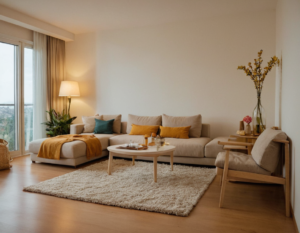Living in a small apartment doesn’t mean you have to sacrifice a cozy and stylish environment.
One of the simplest and most effective ways to breathe new life into your home is by adding plants to your décor. Not only do they beautify the space, but they also help purify the air, create a more tranquil atmosphere, and can even enhance your focus and well-being.
Even in smaller spaces, it’s possible to incorporate greenery in a charming and functional way. In this article, we’ll explore how to choose the best plants and organize your space to ensure that every nook of your apartment comes alive with freshness.
1. Choosing the Right Plants for Small Spaces
When decorating a small apartment with plants, the first step is selecting species that thrive indoors and don’t take up too much space. Some plants are ideal for smaller apartments because they grow well in indirect light, with controlled humidity, and don’t require large areas to flourish.
Compact Plants with Low Maintenance
-
-
- Succulents and Cacti: Perfect for those looking for easy-care plants. With their interesting and varied shapes, they can be placed in small pots on shelves, tables, or windowsills.
- Snake Plant (Sansevieria): Known for its resilience, this plant adapts well to different light conditions and requires little water. Its vertical growth makes it a great option for niches or smaller spaces.
- Pothos (Epipremnum aureum): A fast-growing trailing plant, perfect for hanging supports or high shelves, helping to save floor space.
- ZZ Plant (Zamioculcas): This plant is also easy to care for and tolerates low light. Its modern look and dark green leaves make it an excellent choice to complement interior décor.
-
Plants That Prefer Indirect Light
-
-
- Lady Palm (Rhapis excelsa): A medium-sized plant that does well in indoor spaces with indirect light. Its dense and elegant foliage adds a sophisticated touch to the environment.
- Monstera (Monstera deliciosa): Although it can grow large, its distinctive large leaves can be pruned to fit smaller spaces. It prefers indirect light, making it a great choice for interiors.
-
2. How to Organize Plants in Your Apartment
The way plants are distributed throughout the apartment can make all the difference to the overall look of the space. In small spaces, it’s important to make use of vertical space and optimize distribution to avoid overcrowding.
Shelves and Hanging Supports
To make the most of available space, opt for high shelves or wall-mounted supports. You can place hanging plants like pothos or small pots with succulents or cacti on these supports. Additionally, these decorative elements help create a sense of organization and efficient space use.
Decorative Pots
Invest in pots of various sizes and shapes to add an extra dose of style. Metallic, ceramic, or even concrete pots can help create a more modern or minimalist ambiance. To avoid overwhelming the space, choose a color palette that complements the rest of your apartment’s décor.
Using Baskets and Planters
For a more rustic or boho look, natural fiber baskets (such as bamboo or wicker) can be great options for smaller pots. They are perfect for plants like dracaena, peperomia, or even lucky bamboo. Macramé planters are also a wonderful alternative to suspend plants and add texture to the space.
Green Corners and Highlight Areas
If you have an empty space, such as a corner of the living room or a small balcony, this could be the ideal place to concentrate larger or more eye-catching plants. A plant like monstera or a lady palm can become the focal point of a corner, creating a cozy and vibrant atmosphere.
3. Plant Care in Small Apartments
Although many plants for small spaces are easy to maintain, it’s important to pay attention to some basic care tips to ensure your plants thrive and remain healthy.
-
-
- Watering: In small apartments, watering can be tricky, especially during the winter when humidity levels tend to be lower. Avoid overwatering, as water may evaporate more slowly, promoting root rot. Use a watering control tool, like a moisture meter, or simply check the soil with your finger to determine if the plant needs water.
- Light: While many plants adapt well to indirect light, lack of natural light can be a challenge. If your apartment doesn’t receive direct sunlight or has dimmer areas, consider using grow lights (LED lights specifically for plants) to supplement the lighting. These lights are ideal for providing the necessary light without heating up the space.
- Cleaning: Indoor plants can accumulate dust on their leaves, which can hinder photosynthesis. Regularly wipe the leaves with a damp cloth to prevent dirt buildup and allow the plants to breathe better.
-
4. Benefits of Having Plants in Small Spaces
In addition to enhancing beauty and freshness, having plants at home offers a range of proven benefits for your health and well-being:
-
-
- Air Purification: Many indoor plants, such as ferns, snake plants, and aloe vera, are known for their ability to purify the air by absorbing pollutants and releasing oxygen.
- Stress Reduction and Improved Well-being: The presence of plants can reduce stress levels, enhance focus, and even boost productivity. Studies suggest that environments with plants can improve emotional states and increase feelings of calm.
- Creativity Boost: The green hues of plants can help stimulate creativity, especially in spaces like home offices.
-
Conclusion
-
-
- Transforming your small apartment into a more inviting, vibrant, and nature-filled environment is easier than it seems. With the right plants, smart arrangement, and simple care, you can create a green space that reflects your style and brings health benefits to your life. Remember, regardless of the size of your apartment, nature can always find a special spot to thrive. So, start adding greenery to your home today and enjoy all the benefits it has to offer!
-


